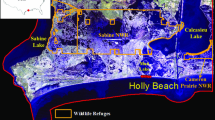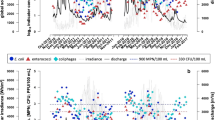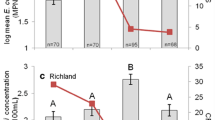Abstract
Given the 24-h turn-around time before swimming advisories are released, advisories issued to protect public health really only indicates ‘it may be unsafe to swim yesterday’. Predictive modelling for Escherichia coli concentrations at inflow-impacted beaches may be a favourable alternative to the current, routinely criticised monitoring approach. Using a total of 482 sets of meteorological and bacteriological data covering 14 swimming seasons, as well as environmental data of 10 inflow streams, this study developed models that could be used for predicting E. coli concentrations at five Lake Rotorua beaches. The models include predictor variables such as wind speed, antecedent rainfall, suspended solids at Puarenga, Utuhina and Ngongotaha stream inflows and particulate inorganic phosphorus concentration at Puarenga stream inflow. The combined 2011–2012 models had an average-adjusted R 2 of 0.73, root mean square error (RMSE) of 0.33 logCFU/100 mL and captured 38 % of the variance in the validation data when used to predict E. coli concentrations for an additional 2 years (2013–2014). Among the individual beach models, predictive accuracy ranged from 88.89 to 92.31 % for the three beaches considered in the study. The developed models can provide a faster estimation of E. coli condition, potentially assisting local beach managers in the decision process related to swimming advisories issuance.







Similar content being viewed by others
References
Abell, J. M., & Hamilton, D. P. (2015). Biogeochemical processes and phytoplankton nutrient limitation in the inflow transition zone of a large eutrophic lake during a summer rain event. Ecohydrology, 8(2), 243–262.
Ahmad, A., Dada, A. C., Usup, G., & Heng, L. Y. (2013). Validation of the enterococci indicator for bacteriological quality monitoring of beaches in Malaysia using a multivariate approach. Springer Plus, 2(1), 425.
Alkan, U., Elliott, D., & Evison, L. (1995). Survival of enteric bacteria in relation to simulated solar radiation and other environmental factors in marine waters. Water Research, 29(9), 2071–2080.
Auer, M. T., & Niehaus, S. L. (1993). Modeling fecal coliform bacteria—I. Field and laboratory determination of loss kinetics. Water Research, 27(4), 693–701.
Boehm, A., Grant, S., Kim, J., Mowbray, S., McGee, C., Clark, C., Foley, D., & Wellman, D. (2002). Decadal and shorter period variability of surf zone water quality at Huntington Beach, California. Environmental Science & Technology, 36(18), 3885–3892.
Boehm, A. B. (2007). Enterococci concentrations in diverse coastal environments exhibit extreme variability. Environmental Science & Technology, 41(24), 8227–8232.
Boehm, A. B., Ashbolt, N. J., Colford, J. M., Dunbar, L. E., Fleming, L. E., Gold, M. A., Hansel, J. A., Hunter, P. R., Ichida, A. M., McGee, C. D., Soller, J. A., & Weisberg, S. B. (2009). A sea change ahead for recreational water quality criteria, Journal of Water and Health 7, 9–20.
BoPRC. (2010). Soils of the Bay of Plenty Volume 1: Western Bay of Plenty Environmental Publication 2010/11-1, 182pp.
Burger, D. F., Hamilton, D. P., & Pilditch, C. A. (2008). Modelling the relative importance of internal and external nutrient loads on water column nutrient concentrations and phytoplankton biomass in a shallow polymictic lake. Ecological Modelling, 211(3), 411–423.
Burkhardt, W., Calci, K. R., Watkins, W. D., Rippey, S. R., & Chirtel, S. J. (2000). Inactivation of indicator microorganisms in estuarine waters. Water Research, 34(8), 2207–2214.
Coyne, M., Gilfillen, R., Rhodes, R., & Blevins, R. (1995). Soil and fecal coliform trapping by grass filter strips during simulated rain. Journal of Soil and Water Conservation, 50(4), 405–408.
Crowther, J., Kay, D., & Wyer, M. D. (2001). Relationships between microbial water quality and environmental conditions in coastal recreational waters: the Fylde coast, UK. Water Research, 35(17), 4029–4038.
Cyterski, M., Zhang, S., White, E., Molina, M., Wolfe, K., Parmar, R., & Zepp, R. (2012). Temporal synchronization analysis for improving regression modeling of fecal indicator bacteria levels. Water, Air, & Soil Pollution, 223(8), 4841–4851.
Cyterski, M., Brooks, W., Galvin, M., Wolfe, K., Carvin, R., Roddick, T., Fienen, M, & S. Corsi. (2015). Virtual Beach 3.0.4: User’s Guide Guide, USEPA. Available online at http://www.epa.gov/sites/production/files/2015-02/documents/vb3_manual_3.0.4.pdf. Accessed 1 March 2016.
Dada, A. C., Ahmad, A., Usup, G., & Heng, L. Y. (2013). Speciation and antimicrobial resistance of enterococci isolated from recreational beaches in Malaysia. Environmental Monitoring and Assessment, 185(2), 1583–1599.
Dada, A. C., Asmat, A., Gires, U., Heng, L. Y., & Deborah, B. O. (2012). Bacteriological monitoring and sustainable management of beach water quality in Malaysia: problems and prospects. Global Journal of Health Science, 4(3), p126.
de Brauwere, A., Ouattara, N. K., & Servais, P. (2014). Modeling fecal indicator bacteria concentrations in natural surface waters: a review. Critical Reviews in Environmental Science and Technology, 44(21), 2380–2453.
Devane, M., Gilpin, B., & Moriarty, E. (2015). Human health risks of faecal pollution from different sources: a review of the literature.
Duran, A., Muniesa, M., Mendez, X., Valero, F., Lucena, F., & Jofre, J. (2002). Removal and inactivation of indicator bacteriophages in fresh waters. Journal of Applied Microbiology, 92(2), 338–347.
EPA. (1976). Quality criteria for water. Washington, DC: U. S. Environmental Protection Agency; EPA-440976023.
EPA. (1986). Ambient water quality criteria for bacteria. Washington, DC: U. S. Environmental Protection Agency. EPA A440/5-84-002.
EPA. (2002). Method 1103.1: Escherichia coli (E. coli) in water by membrane filtration using membrane-thermotolerant Escherichia coli agar (mTEC). Office of Water, U.S. Environmental Protection Agency.
Feng, Z., Reniers, A., Haus, B. K., Solo-Gabriele, H. M., Wang, J. D., & Fleming, L. E. (2015). A predictive model for microbial counts on beaches where intertidal sand is the primary source. Marine Pollution Bulletin, 94(1), 37–47.
Francy, D. S., Darner, R. A., & Bertke, E. E. (2006). Models for predicting recreational water quality at Lake Erie beaches. Reston, VA: U.S. Geological Survey.
Francy, D. S., Stelzer, E. A., Duris, J. W., Brady, A. M., Harrison, J. H., Johnson, H. E., & Ware, M. W. (2013). Predictive models for Escherichia coli concentrations at inland lake beaches and relationship of model variables to pathogen detection. Applied and Environmental Microbiology, 79(5), 1676–1688.
Frick, W. E., Ge, Z., & Zepp, R. G. (2008). Nowcasting and forecasting concentrations of biological contaminants at beaches: a feasibility and case study. Environmental Science & Technology, 42(13), 4818–4824.
Ge, Z., & Frick, W. E. (2007). Some statistical issues related to multiple linear regression modeling of beach bacteria concentrations. Environmental Research, 103(3), 358–364.
Ge, Z., Nevers, M. B., Schwab, D. J., & Whitman, R. L. (2010). Coastal loading and transport of Escherichia coli at an embayed beach in Lake Michigan. Environmental Science & Technology, 44(17), 6731–6737.
Ge, Z., Whitman, R. L., Nevers, M. B., Phanikumar, M. S., & Byappanahalli, M. N. (2012). Nearshore hydrodynamics as loading and forcing factors for Escherichia coli contamination at an embayed beach. Limnology and Oceanography, 57(1), 362–381.
Genthner, F. J., James, J. B., Yates, D. F., & Friedman, S. D. (2005). Use of composite data sets for source-tracking enterococci in the water column and shoreline interstitial waters on Pensacola Beach, Florida. Marine Pollution Bulletin, 50(7), 724–732.
Gonzalez, R. A., Conn, K. E., Crosswell, J. R., & Noble, R. T. (2012). Application of empirical predictive modeling using conventional and alternative fecal indicator bacteria in eastern North Carolina waters. Water Research, 46(18), 5871–5882.
Green, H. C., Dick, L. K., Gilpin, B., Samadpour, M., & Field, K. G. (2012). Genetic markers for rapid PCR-based identification of gull, Canada goose, duck, and chicken fecal contamination in water. Applied and Environmental Microbiology, 78(2), 503–510.
Guber, A. K., Pachepsky, Y. A., Shelton, D. R., & Yu, O. (2007). Effect of bovine manure on fecal coliform attachment to soil and soil particles of different sizes. Applied and Environmental Microbiology, 73(10), 3363–3370.
Haack, S. K., Fogarty, L. R., Stelzer, E. A., Fuller, L. M., Brennan, A. K., Isaacs, N. M., & Johnson, H. E. (2013). Geographic setting influences Great Lakes beach microbiological water quality. Environmental Science & Technology, 47(21), 12054–12063.
Hamilton, D. P., McBride, C.G., Jones H.F.E (2014). Assessing the effects of alum dosing of two inflows to Lake Rotorua against external nutrient load reductions: model simulations for 2001–2012. Environmental Research Institute Report 49, University of Waikato, Hamilton, 56 pp.
Hartmann, J., Beckerman, S., Engeman, R. M., & Seamans, T. (2013). Report to the City of Chicago on Conflicts with Ring-billed Gulls and the 2012 Integrated Ring-billed Gull Damage Management Project.
Hernandez, R. J., Hernandez, Y., Jimenez, N. H., Piggot, A. M., Klaus, J. S., Feng, Z., Reniers, A., & Solo-Gabriele, H. M. (2014). Effects of full-scale beach renovation on fecal indicator levels in shoreline sand and water. Water Research, 48, 579–591.
Hickey, C. W., & Gibbs, M. M. (2009). Lake sediment phosphorus release management—decision support and risk assessment framework. New Zealand Journal of Marine and Freshwater Research, 43(3), 819–856.
Hipsey, M. R., Brookes, J. D., Regel, R. H., Antenucci, J. P., & Burch, M. D. (2006). In situ evidence for the association of total coliforms and Escherichia coli with suspended inorganic particles in an Australian reservoir. Water, Air, and Soil Pollution, 170(1–4), 191–209.
Hong, H., Qiu, J., & Liang, Y. (2010). Environmental factors influencing the distribution of total and fecal coliform bacteria in six water storage reservoirs in the Pearl River Delta Region, China. Journal of Environmental Sciences, 22(5), 663–668.
Ishii, S., Nakamura, T., Ozawa, S., Kobayashi, A., Sano, D., & Okabe, S. (2014). Water quality monitoring and risk assessment by simultaneous multipathogen quantification. Environmental Science & Technology, 48(9), 4744–4749.
Jeng, H. C., England, A. J., & Bradford, H. B. (2005). Indicator organisms associated with stormwater suspended particles and estuarine sediment. Journal of Environmental Science and Health, 40(4), 779–791.
Juhna, T., Birzniece, D., & Rubulis, J. (2007). Effect of phosphorus on survival of Escherichia coli in drinking water biofilms. Applied and Environmental Microbiology, 73(11), 3755–3758.
Kannel, P. R., Lee, S., Lee, Y.-S., Kanel, S. R., & Khan, S. P. (2007). Application of water quality indices and dissolved oxygen as indicators for river water classification and urban impact assessment. Environmental Monitoring and Assessment, 132(1–3), 93–110.
Kay, D., Stapleton, C., Wyer, M., McDonald, A., Crowther, J., Paul, N., Jones, K., Francis, C., Watkins, J., & Wilkinson, J. (2005). Decay of intestinal enterococci concentrations in high-energy estuarine and coastal waters: towards real-time T 90 values for modelling faecal indicators in recreational waters. Water Research, 39(4), 655–667.
Liu, L., Phanikumar, M. S., Molloy, S. L., Whitman, R. L., Shively, D. A., Nevers, M. B., Schwab, D. J., & Rose, J. B. (2006). Modeling the transport and inactivation of E. coli and enterococci in the near-shore region of Lake Michigan. Environmental Science & Technology, 40(16), 5022–5028.
Marshall, K. C. (1971). Sorptive interactions between soil particles and microorganisms. In A. D. McLaren & J. Skujins (Eds.), Soil biochemistry (pp. 409–445). New York: Marcel Dekker.
McCarthy, D., Deletic, A., Mitchell, V., & Diaper, C. (2011). Development and testing of a model for Micro-Organism Prediction in Urban Stormwater (MOPUS). Journal of Hydrology, 409(1), 236–247.
McCarthy, D., Hathaway, J., Hunt, W., & Deletic, A. (2012). Intra-event variability of Escherichia coli and total suspended solids in urban stormwater runoff. Water Research, 46(20), 6661–6670.
MfE & MoH. (2003). Microbiological water quality guidelines for marine and freshwater recreational areas. Wellington, New Zealand, Ministry for the Environment and Ministry of Health. 159 p.
Nevers, M. B., & Whitman, R. L. (2005). Nowcast modeling of Escherichia coli concentrations at multiple urban beaches of southern Lake Michigan. Water Research, 39(20), 5250–5260.
Nevers, M. B., & Whitman, R. L. (2011). Efficacy of monitoring and empirical predictive modeling at improving public health protection at Chicago beaches. Water Research, 45(4), 1659–1668.
NPS. (2014). Human health for recreation, New Zealand National Policy Statement for Freshwater Management 34pp. Available at http://www.mfe.govt.nz/sites/default/files/media/Fresh%20water/nps-freshwater-management-jul-14.pdf
Olyphant, G. A. (2005). Statistical basis for predicting the need for bacterially induced beach closures: emergence of a paradigm? Water Research, 39(20), 4953–4960.
Olyphant, G. A., & Whitman, R. L. (2004). Elements of a predictive model for determining beach closures on a real time basis: the case of 63rd Street Beach Chicago. Environmental Monitoring and Assessment, 98(1–3), 175–190.
Peryer-Fursdon, J., Abell, J. M., Clarke, D., Özkundakci, D., Hamilton, D. P., & Pearson, L. (2015). Spatial variability in sediment phosphorus characteristics along a hydrological gradient upstream of Lake Rotorua, New Zealand. Environmental Earth Sciences, 73(4), 1573–1585.
Rippy, M., Franks, P., Feddersen, F., Guza, R., & Warrick, J. (2013). Beach nourishment impacts on bacteriological water quality and phytoplankton bloom dynamics. Environmental Science & Technology, 47(12), 6146–6154.
Rutherford, J.C., Tait, A., Palliser, C. C., Wadha, S. & Rucinski, D., (2008). Water balance modelling in the Lake Rotorua catchment. NIWA Client Report HAM2008-048, National Institute of Water and Atmospheric Research Ltd, Hamilton.
Schoen, M. E., & Ashbolt, N. J. (2010). Assessing pathogen risk to swimmers at non-sewage impacted recreational beaches. Environmental Science & Technology, 44(7), 2286–2291.
Shelton, D., Pachepsky, Y., Kiefer, L., Blaustein, R., McCarty, G., & Dao, T. (2014). Response of coliform populations in streambed sediment and water column to changes in nutrient concentrations in water. Water Research, 59, 316–324.
Shen, H. W., Julien, P. Y., & Maidment, D. (1992). Erosion and sediment transport. Handbook of hydrology, 12.11-12.61.
Shibata, T., Solo-Gabriele, H. M., Sinigalliano, C. D., Gidley, M. L., Plano, L. R., Fleisher, J. M., Wang, J. D., Elmir, S. M., He, G., & Wright, M. E. (2010). Evaluation of conventional and alternative monitoring methods for a recreational marine beach with nonpoint source of fecal contamination. Environmental Science & Technology, 44(21), 8175–8181.
Sinton, L. W., Hall, C. H., Lynch, P. A., & Davies-Colley, R. J. (2002). Sunlight inactivation of fecal indicator bacteria and bacteriophages from waste stabilization pond effluent in fresh and saline waters. Applied and Environmental Microbiology, 68(3), 1122–1131.
Soller, J. A., Schoen, M. E., Bartrand, T., Ravenscroft, J. E., & Ashbolt, N. J. (2010). Estimated human health risks from exposure to recreational waters impacted by human and non-human sources of faecal contamination. Water Research, 44(16), 4674–4691.
Soller, J. A., Schoen, M. E., Varghese, A., Ichida, A. M., Boehm, A. B., Eftim, S., Ashbolt, N. J., & Ravenscroft, J. E. (2014). Human health risk implications of multiple sources of faecal indicator bacteria in a recreational waterbody. Water Research, 66, 254–264.
Søndergaard, M., Jensen, J. P., & Jeppesen, E. (2003). Role of sediment and internal loading of phosphorus in shallow lakes. Hydrobiologia, 506(1–3), 135–145.
Stapleton, C., Crowther, J., Falconer, R., Francis, C., Humphrey, N., Kashefipour, S., Kay, D., Lin, B., Paul, N., & Watkins, J. (2004). Modelling the fate and transport of particles in water (Phase II). Bristol, Environment Agency: 232p.
Sun, C.-C., Wang, Y.-S., Wu, M.-L., Dong, J.-D., Wang, Y.-T., Sun, F.-L., & Zhang, Y.-Y. (2011). Seasonal variation of water quality and phytoplankton response patterns in Daya Bay, China. International Journal of Environmental Research and Public Health, 8(7), 2951–2966.
Thoe, W., Gold, M., Griesbach, A., Grimmer, M., Taggart, M., & Boehm, A. (2014). Predicting water quality at Santa Monica Beach: evaluation of five different models for public notification of unsafe swimming conditions. Water Research, 67, 105–117.
Trolle, D., Jørgensen, T. B., & Jeppesen, E. (2008). Predicting the effects of reduced external nitrogen loading on the nitrogen dynamics and ecological state of deep Lake Ravn, Denmark, using the DYRESM–CAEDYM model. Limnologica-Ecology and Management of Inland Waters, 38(3), 220–232.
Wade, T. J., Pai, N., Eisenberg, J., & Colford, J. (2003). Do US EPA water quality guidelines for recreational waters prevent gastrointestinal illness? A systematic review and metaanalysis. Environ. Health Perspect, 111(8).
Whitman, R. L., & Nevers, M. B. (2008). Summer E. coli patterns and responses along 23 Chicago beaches. Environmental Science & Technology, 42(24), 9217–9224.
Whitman, R. L., Nevers, M. B., Korinek, G. C., & Byappanahalli, M. N. (2004). Solar and temporal effects on Escherichia coli concentration at a Lake Michigan swimming beach. Applied and Environmental Microbiology, 70(7), 4276–4285.
Wilkinson, J., Jenkins, A., Wyer, M., & Kay, D. (1995). Modelling faecal coliform dynamics in streams and rivers. Water Research, 29(3), 847–855.
Zhang, Z., Deng, Z., & Rusch, K. A. (2012). Development of predictive models for determining enterococci levels at Gulf Coast beaches. Water Research, 46(2), 465–474.
Zmirou, D., Pena, L., Ledrans, M., & Letertre, A. (2003). Risks associated with the microbiological quality of bodies of fresh and marine water used for recreational purposes: summary estimates based on published epidemiological studies. Archives of Environmental Health: An International Journal, 58(11), 703–711.
Acknowledgments
The corresponding author’s post-doctoral study was supported by a University of Waikato Deputy Vice-Chancellor Freshwater Initiative. Support for this research by the Bay of Plenty Regional Council is gratefully acknowledged. Thanks to Chris McBride and Dr Jonathan Abell for providing the DYCD forcing file for years 2001–2012 and 2007–2014, respectively. Thanks to Dr Jonathan Abell for reading through the manuscript. An abstract of the manuscript was presented at the New Zealand Association Water Conference - Silverstream, Wellington (23–26 November 2015) with travel fund support provided by the University of Waikato.
Author information
Authors and Affiliations
Corresponding author
Rights and permissions
About this article
Cite this article
Dada, A.C., Hamilton, D.P. Predictive Models for Determination of E. coli Concentrations at Inland Recreational Beaches. Water Air Soil Pollut 227, 347 (2016). https://doi.org/10.1007/s11270-016-3033-6
Received:
Accepted:
Published:
DOI: https://doi.org/10.1007/s11270-016-3033-6




